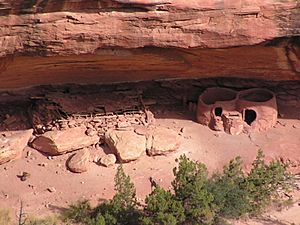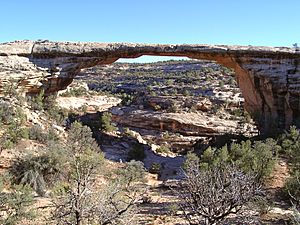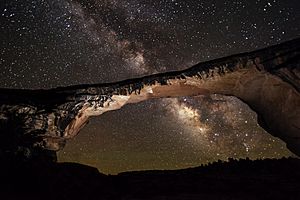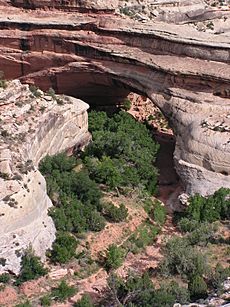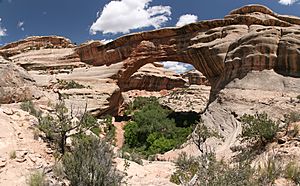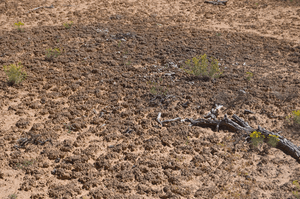Natural Bridges National Monument facts for kids
Quick facts for kids Natural Bridges National Monument |
|
|---|---|
|
IUCN Category V (Protected Landscape/Seascape)
|
|

Owachomo Natural Bridge
|
|
| Lua error in Module:Location_map at line 420: attempt to index field 'wikibase' (a nil value). | |
| Location | San Juan County, Utah, United States |
| Area | 7,636 acres (30.90 km2) |
| Created | April 16, 1908 |
| Visitors | 101,843 (in 2016) |
| Governing body | National Park Service |
| Website | Natural Bridges National Monument |
The Natural Bridges National Monument is a special place in southeast Utah, United States. It's about 50 miles (80 km) northwest of the Four Corners area. This monument is famous for its amazing natural bridges. These bridges are carved out of white sandstone.
There are three main bridges in the park: Kachina, Owachomo, and Sipapu. Sipapu is the largest of the three. All these names come from the Hopi people. A natural bridge forms when water flowing in a canyon slowly wears away the rock. Over time, the water cuts through rock walls, creating a bridge. Eventually, these bridges can collapse due to erosion and gravity. Scientists have found signs of at least two collapsed bridges here.
Contents
History of Natural Bridges
Humans have lived around Natural Bridges for a very long time. People were here as early as 7500 BCE. We know this from old rock art and stone tools found in the area.
Ancient Puebloan People
Around 700 CE, ancestors of today's Puebloan people moved to this area. They built homes and storage buildings from stone and mortar. These buildings look similar to those found in Mesa Verde National Park. You can even see Mesa Verde in the distance from the Bears Ears area. Like the people at Mesa Verde, the residents of Natural Bridges left the region around the year 1270.
First European Visitors
The first Europeans came to the area in 1883. A gold prospector named Cass Hite followed White Canyon upstream. He discovered the bridges where White Canyon and Armstrong Canyon meet. In 1904, the National Geographic Magazine wrote about the bridges.
Becoming a National Monument
Because of the interest, President Theodore Roosevelt made the area a National Monument on April 16, 1908. It was the very first National Monument in Utah! For many years, it was hard to get to the Monument. It was a three-day horseback ride from the nearest town. Not many people visited until the 1950s. At that time, new roads were built because of a "uranium boom." This made it much easier for people to visit the park.
How the Bridges Formed
The amazing bridges and other landforms you see at Natural Bridges were shaped by erosion. Erosion is when wind, rain, and water slowly wear away rock.
The Power of Water
The Colorado Plateau, where the Monument is, has been pushed up about 12,000 feet (3,658 meters) over millions of years. As the land rose, rivers and streams started cutting into the rock faster. The Colorado River, for example, carved its path in the last 6 million years. This powerful water carved out the canyons and carried away rock, creating the landscape we see today.
Plants and Soil
The Monument is about 6,500 feet (1,981 meters) high. Most of the area has pinyon-juniper forests. You'll also find grasses and shrubs like sage. In the canyons, where there's more water, you can see willow, oak, and cottonwood trees. The Monument also has special cryptobiotic soils. These are living crusts on the ground that help prevent erosion and keep the soil healthy.
Bridge Stability
Natural bridges are always changing due to natural forces. For example, Owachomo Bridge in Armstrong Canyon is only 9 feet (3 meters) thick at its top.
Earthquakes can happen in the region, though not very often. Even small ground shaking from earthquakes could affect the bridges. This might cause one or more of them to collapse over a very long time.
Things to See and Do
The main attractions are the three natural bridges. You can see them from the Bridge View Drive, which goes past all three. You can also hike down to the base of each bridge. The park has a campground, picnic areas, and a visitor center. The electricity for the park comes from a large solar power system near the visitor center.
Dark Skies and Ancient Ruins
In 2007, Natural Bridges became the first International Dark-Sky Park. This means the park has some of the darkest and clearest night skies in the United States. The park works hard to protect this natural darkness. It's a great place for stargazing!
You can also visit Horsecollar Ruin. This is an Ancestral Puebloan ruin that you can see from an overlook. The site is over 700 years old but is very well preserved. It includes a kiva (a special ceremonial room) with its original roof. There are also two granaries (storage buildings) with unique oval-shaped doors. These doors look like horse collars, which is how the ruin got its name.
Bridge Dimensions
Here are the sizes of the three main bridges:
| Bridge | Height m (ft) |
Span m (ft) |
Width m (ft) |
Thickness m (ft) |
|---|---|---|---|---|
| Owachomo | 32 (106) | 55 (180) | 8 (27) | 3 (9) |
| Sipapu | 67 (220) | 68 (225) | 9.5 (31) | 16 (53) |
| Kachina | 64 (210) | 62 (204) | 13 (44) | 28 (93) |
Plants and Animals
Natural Bridges National Monument is home to many different plants and animals.
Animals You Might See
You can find many birds here, like the pinyon jay and canyon wren. You might also spot turkeys, which were brought back to the area by the State of Utah. Mammals living in the Monument include rabbits, pack rats, bobcats, coyotes, bears, mule deer, and mountain lions. Several types of lizards are common in southern Utah. The Monument's pygmy rattlesnakes have also been studied by scientists.
Plants You Might See
The native plants include willow, cottonwood, Douglas fir, ponderosa pine, pinyon pine, and juniper trees. You'll also find many grasses and wildflowers like asters and penstemons. Different shrubs like dwarf oaks, sage, and yucca grow here too. Some plants that are not native, like tumbleweeds, can also be found.
A lot of the ground in the Monument is covered by cryptobiotic soil crusts. These living crusts are very important! They help stop the soil from washing away and keep nutrients in the soil.
|
See also
 In Spanish: Monumento nacional de los Puentes Naturales para niños
In Spanish: Monumento nacional de los Puentes Naturales para niños


